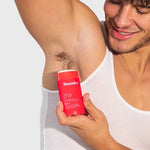Iontophoresis is a treatment for excessive perspiration, usually in the hands or feet. It can also be used for a variety of injuries. It's not painful, and it's safe for most people. However, it should be noted that it's contraindicated for some people.
Iontophoresis is a treatment for hyperhidrosis that uses low-voltage currents to close sweat glands in the hands and feet. The treatment is very effective and is generally used to control excessive sweating. Treatments can take several sessions to achieve desired results.
Iontophoresis works by blocking the transmission of sympathetic nerves in the body and by lowering the pH level of the skin. It is considered safe, but some side effects do exist. It can cause redness and itching, pins and needles, and discomfort. People with epilepsy, heart problems, or cancer should not undergo iontophoresis. Pregnant women should also avoid it.
Although iontophoresis is generally safe, it is important to discuss any side effects with your doctor. It may cause a mild tingling sensation and can cause skin thickening in some patients. It is possible to minimize the amount of this side effect by reducing the frequency of treatment.
Iontophoresis has been used to treat excessive sweating of the hands and feet since the 1940s. The treatment is effective for some patients, but it is not a cure for hyperhidrosis. Usually, it can help alleviate symptoms for a short time and can even prevent the development of other serious problems.
The treatment is effective in most patients within a month. It can also help control sweating on other parts of the body. It is generally performed three times a week until the sweating underarms and hands are under control. Patients may need maintenance treatments every 2-4 weeks.
The treatment is used to treat a variety of sweat-related problems, including palmar hyperhidrosis, axillary hyperhidrosis, and plantar hyperhidrosis.
It can be used to treat a variety of injuries
Iontophoresis works by introducing ions through electrical current to a patient's skin. It's a noninvasive treatment method that's often used in conjunction with physical therapy to help patients recover faster from injuries. This type of therapy is effective for treating many injuries, including soft tissue and muscle damage, and can also be used to help treat pain from a variety of conditions.
The treatment is painless and can be done in a doctor's office. The physical therapist will discuss the best course of treatment with the patient to ensure that the treatment is a success. In many cases, patients will feel immediate relief after their session. However, it's important to remember that pain medication can only be effective for a limited time.
Iontophoresis is an effective treatment for pain and inflammation. The physical therapist will determine which type of medication is best for a particular condition. Usually, a mild electrical current will be applied to the area. A tingling sensation will occur, but it shouldn't be painful. The sessions typically last about 10 to 15 minutes and are painless. There are some people who experience some side effects, but these are not serious.
Some people experience mild tingling sensations during iontophoresis treatment. The current shouldn't be painful, but patients should report any sensations they have while wearing the patch to the affected area. If the sensations persist, patients should stop wearing the patch and contact their physical therapist.
There are several different types of iontophoresis treatments. One of these is transcutaneous iontophoresis. The process involves delivering a charged medication via an electrical current to the affected area. This treatment is mostly used in occupational and physical therapy settings. In the emergency department, however, there is little evidence to support the use of this treatment.
Contraindications
While the use of iontophoresis can be beneficial for certain conditions, this treatment is not suitable for everyone. Patients who are pregnant or have metal implants in their feet should not undergo the procedure. The currents generated by iontophoresis are very stressful for the body. Patients with skin diseases, epilepsy, and heart conditions are also not good candidates for iontophoresis.
In addition to pregnancy, iontophoresis is contraindicated during breastfeeding. The currents and tiny eats may stress the baby. Because of these risks, iontophoresis should be used only after careful consideration and consulting with a doctor.
Is it painful?
Unlike some medical procedures, iontophoresis is painless. However, some side effects may occur. Most commonly, patients will experience dry skin after the procedure. Some people may also experience irritation or blistering. If you are concerned that iontophoresis might hurt, consult a physician or physical therapist.
Iontophoresis delivers medications by means of a mild electrical current. The most common medication used during iontophoresis is dexamethasone sodium phosphate. Other medications may be used depending on the needs of the patient. Some patients have a negative reaction to the treatment, and this is completely normal.
Using an iontophoresis device requires a special type of electrical current, which is not available with a typical muscle stimulator. In order to move the medication through the skin, the medications must dissociate into electrically charged ions in solution. Because the current repels like-charged ions and attracts opposite-charged ions, a special kind of electrode must be used to conduct it. Also, it must be continuous and monophasic, or else the medication would retract.
Iontophoresis is a safe procedure that can help reduce pain. However, some patients may experience tingling or burning at the electrode sites. Despite these minor side effects, they are often manageable and do not cause any major harm. Most patients only need a few treatments over the course of two weeks.
Iontophoresis can be extremely effective for hyperhidrosis. It is generally used as a treatment for palmar, plantar, and foot hyperhidrosis. Treatments can be repeated as often as three times a week, and it can improve symptoms in 85% to 90% of people.
Is it causes persistent sweating?
If you suffer from persistent sweating, iontophoresis treatment may be an option for you. This method of treating hyperhidrosis uses an electrical current delivered through water to the problem areas. The technique has been used for over 70 years and is generally considered safe and effective. There are some side effects of iontophoresis, though. For example, some patients think that it causes their sweating to become more intense. But this is difficult to prove.
Another side effect of iontophoresis is skin thinning or redness. The procedure also causes mild to moderate itchiness of the treated area. This is not a serious side effect and can be treated by reducing the frequency of treatments and reducing the duration.
You should consult a dermatologist or physician before trying iontophoresis. Some insurance carriers do not cover iontophoresis for hyperhidrosis. However, some physicians may be willing to negotiate the cost of treatments with patients without insurance. The cost of the treatment is typically based on the severity of the condition.
If this treatment doesn't improve your condition, a doctor may suggest surgery. Surgical treatments may involve the removal of the sweat glands and affecting the nerves that control sweating. However, this is generally not a viable option for isolated head and neck sweating.
Aside from medication, iontophoresis is an alternative treatment for persistent sweating. This treatment uses mild electrical currents to block the sweat glands temporarily. It is most commonly used to treat hyperhidrosis, which causes excessive sweating. The treatment is safe and can be used in combination with other treatments.



